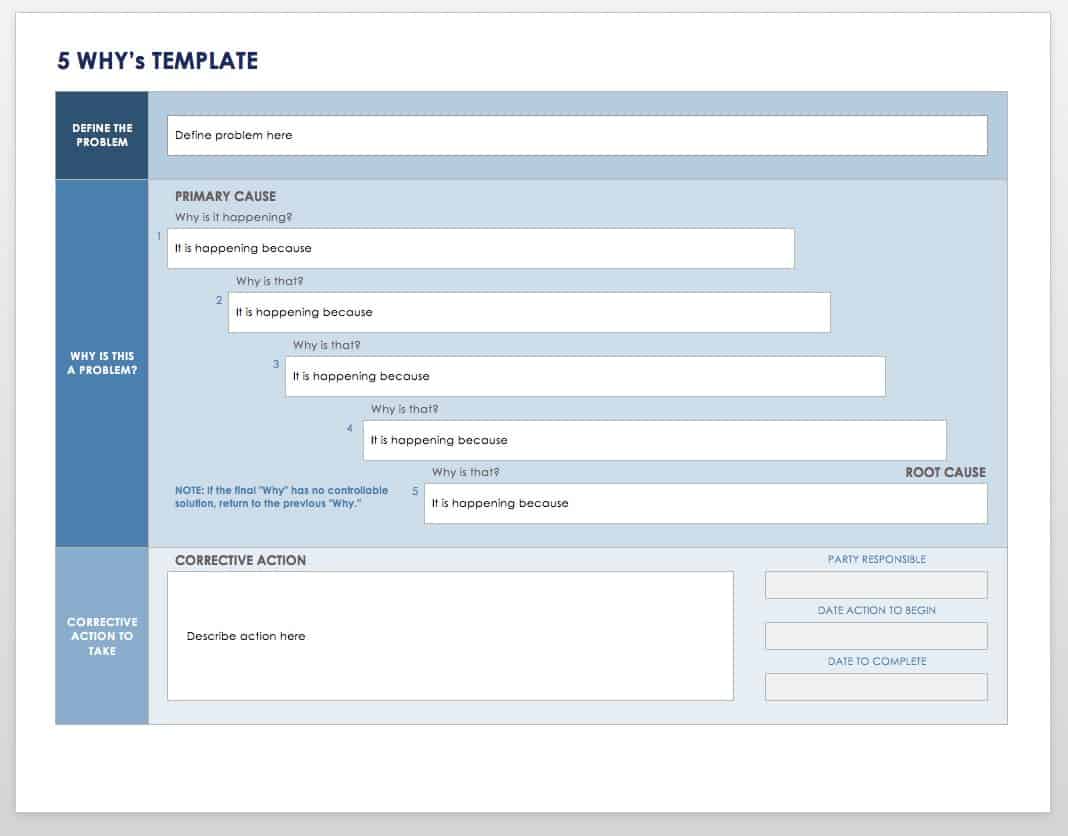How to Write OKRs
Organizations of all sizes and industry types use OKRs to set goals on an annual, quarterly, or monthly basis. An objective refers to a specific goal, and the key results are the measurable milestones that go toward achieving your goal.
You can think of OKRs this way: You might have a big plan, such as becoming the most profitable graphics company in your town. Create objectives that offer smaller, manageable steps toward your big goal, and set key results to note events that contribute to and measure your success.
It’s critical to remember that OKRs represent more than just tasks — rather, OKRs reflect successful change and outcomes. Key results usually include activities with targets, but merely ticking items on a to-do list does not always lead to measurable change. Ensure that your OKRs lead to a beneficial result.
Use the following formula to write OKRs:
OKR = Objective + 3 to 5 Key Results
OKR = Intent + Milestones
When creating OKRs, keep in mind that a good OKR answers the following questions:
- Where do you want to go? (This is your objective.)
- How do you know whether you’re close or you’ve arrived? (These are your key results.)
To learn more about writing OKRs, read our OKR essentials article.
John Doerr is a venture capitalist and author of the book Measure What Matters, in which he discusses the OKR creation process. He uses the following example in his book to illustrate the above formula:
I will (objective) as measured by ( set of key results):
I will boost my company’s annual income by:
- Raising hourly rates by 3 percent for all writing and designing projects
- Sending a minimum of 50 letters of interest to prospects each week
- Seeking 4 retainer projects.
You can find more OKR examples and samples in this article.
Step-by-Step Guide to Writing OKRs
Although each specific OKRs will be unique to your organization, you can use a common process for writing them that should yield success. These steps will help you understand the context of the OKRs and the types of OKRs that suit your situation.
When writing OKRs, also consider that it’s better to not create an OKR than to rush and create a principle that is unclear and unworkable.
- Orient Yourself: Be aware of company objectives and understand what problems the team will tackle. “It should be easy to write OKRs, but frequently, corporate and team objectives don’t align,” says Darrel Whiteley, a Master Black Belt, Lean Master, and Kaizen expert with Firefly Consulting. “You get a corporate objective like, ‘Increase revenue by $20 million,’ and then on the product line, you get an objective like, ‘Make more products.’ That's the mistake I see most frequently: The corporate objectives don't deploy in a way that's understandable at the ground level. However, sometimes the reverse is true. On the line, safety may be important, but that objective doesn’t apply to corporate.”
- Select an OKR Tool: Choose a tool for recording, storing, and sharing OKRs. Purpose-built platforms are available, but a collaboration platform or even a simple spreadsheet can work. You can use a flipchart or white board for a smaller group, but digital tools enable you to monitor and track OKRs, as well as update progress. Additionally, digital tools can archive past OKRs for future reference.
- Write the OKRs: Keep things simple, crisp, and clear. Consider what will make a relevant difference to your team over the next 90 days. Be realistic, and consider the cultural and market context when creating a goal. Also, think of OKRs as a way to corral resources and attention when staff may feel pulled in multiple directions.
Teams and companies usually set three to five OKRs per cadence cycle (annual, quarterly, monthly, or otherwise). Christina Wodtke, speaker and author of the OKR-based book Radical Focus and a recent book, The Team that Managed Itself, suggests picking one objective per quarter — that’s all people can focus on when prioritizing day-to-day tasks. "Pick something for the quarter that you haven't done for a long time,” she suggests. “Often, things that are important but not urgent get postponed. Ask, ‘What do we need to do that will truly make a difference?’ Then it becomes important and urgent." Read our comprehensive guide to workload management to learn more about prioritizing resources. - Align OKRs: Alignment refers to how OKRs work together throughout an organization. Top-level OKRs provide guidance for the overall company direction. Then teams and individuals create OKRs that contribute to those goals. Individuals and teams might also suggest OKRs that percolate up to higher levels of management.
In some organizations, OKRs cascade down throughout the company. One level in the company sets an OKR, and the lower levels assume its key results as their own objectives. But doing so poses some difficulties; if you need to change key results, you directly impact the lower levels’ objectives, and you might have to change course. With cascading goals, it can also take months to set goals as teams wait for upper levels to develop their OKRs.
A top-down cascade is called strict alignment, which you might need to impose for some efforts. In contrast, many experts advocate for a freer approach called directional alignment, where teams and individuals leverage the transparency of process to adopt OKRs from anywhere in the organization. - Set Cadence: The term cadence describes how often you review and score an OKR. Company OKRs may have a year-long cadence, whereas team OKRs usually follow a quarterly or monthly cycle. Large departments and divisions might also set annual OKRs.
Sometimes, an organization will apply a nested cadence, or a variety of cadences. Some practitioners discourage this practice because it can limit synchronization opportunities, but different cadences can match the needs of different organizations:- If you’re a startup that needs to pivot quickly to adapt to market changes, a six-month cadence won’t work. If you review often, you can adjust quickly and easily.
- Frequent progress reviews also remove the need for a complete roadmap.
- Shorter cadences can help you accomplish specific aims. For behavioral and cultural changes, monthly or quarterly cadences work better.
- Longer cadences suit businesses that don't need to pivot immediately when adapting to changes. Long cadences might also work best when your organization is less proficient at OKR processes.
- Longer cadences suit less pressing issues.
If your company is new to OKRs, start with one cadence per department. You might even consider continuing with one cadence for the organization.
- Establish Reviews: For each cadence, establish mid-term and end-term reviews. In addition, set up weekly check-ins within each team, and adjust key results as needed, keeping external constraints in mind. And remember to celebrate and recognize milestones.
- Communicate about OKRs: Share team and company OKRs widely, so people know what they’re working toward and how they can help colleagues and other teams achieve their objectives.
- Review Your OKRs: At the end of each term, carry over any unfinished items (if they are still relevant). You might continue with the same objectives from quarter to quarter, but you either achieve key results or adapt them to meet new circumstances. If you achieve key results, you might convert them to key performance indicators (KPIs), which track daily business processes. For more information on the difference between the two metrics, see our OKR vs. KPI guide.
What Is the Purpose of OKRs?
The purpose of an OKR is to connect an organization’s vision and strategy to execution. Management statements, such as mission statements, KPIs, and OKRs, are communication vehicles that aim to clarify to staff how they should orient their efforts to contribute to growth, improvement, and change. Poor communication of company goals can lead even the best plans astray.
Dan Montgomery is the author of Start Less, Finish More: Building Strategic Agility with OKRs. “Too much of what you see out there about OKRs is very prescriptive, and in fact, you need to tailor an OKR to your organization,” he says. “OKRs really need to reflect the deeper organizational strategy. That's why, when we work with companies, we always have a conversation about strategy before we start. It's essential that everybody has a sense of the overall goals of the organization and to communicate that.”
Types of OKRs with Examples
Understanding the differences among the many types of OKRs can help you to craft your goals. Below is a list of the most common types of OKRs:
- Strategic OKRs are objectives that focus on the company vision and the long-range view. In most cases, you will set strategic OKRs annually for the company.
Example: Have the most successful cat treats brand. - Tactical OKRs provide teams with focused, shorter-term targets.
Example: Kitchen team will create the tastiest cat snack recipes. Marketing team will delight cat owners with our packaging. - Committed OKRs are high-priority goals that a team dedicates themselves to completing. When scoring committed OKRs, they should receive a 1.0 mark. Any score less than 1.0 indicates failure. The inability to achieve a 1.0 tally demands a discussion about how teams can improve processes.
Example: Beat 2020 fourth-quarter sales.
Learn more about scoring OKRs in our guide. - Aspirational OKRs are big goals that stretch staff capabilities or reflect the organization’s broader vision. While you might complete them and score a 1.0, a mark of 0.7 is also acceptable, as it indicates progress in the goal’s direction. Aspirational goals might persist throughout multiple successive cadences.
Example: Provide a healthy eating experience to pets all over the world. - Shared OKRs are ideal for instances in which teams must collaborate to push the company forward and would benefit from developing OKRs together.
Example: For a shared OKR, an organization might set an objective of becoming the top home gardeners retailer, and the key results are to get 25 percent renewals for seed subscriptions (customer care); energize customer retention (marketing); and achieve 12 percent month-over-month growth (sales). - Company OKRs focus on the big picture. Ideally, they become what some call the “guiding star” for activity in a period.
Example: Create a team of great speakers. - Team OKRs interpret company OKRs in the context of the team’s skills and function. Teams sometimes create localized goals that indirectly influence company objectives. Alternatively, they might recommend objectives that percolate up.
Example: Host at least eight monthly team brown bags.
OKR Goal-Setting Template with Gantt
Download OKR Goal-Setting Worksheet Template with Gantt Chart
Use this goal-setting worksheet to draft your OKRs. The template includes space to record company strategy, so you can align your objectives with company aims. You’ll also find space to note any potential obstacles to achieving these goals and sketch out any initiatives for attaining key results, and then track work on the Gantt chart.
OKR Goal-Setting Plan Template for PDF and Word
Download OKR Goal-Setting Template with Gantt
Microsoft Word | Adobe PDF | Smartsheet
Keep your company vision top-of-mind with this OKR writing template. Include notes on why the importance of the OKR and the ideal outcomes for achieving it. Track blockers and resources for completing key results.
You’ll find more useful free, downloadable templates to help you plan OKRs and reach long-term goals, in our OKR template article.
The Key to Identifying Objectives
Objectives should be brief, memorable, aligned, impactful, and inspiring. Use language that describes movement and progress rather than maintaining the status quo. That said, be clear and avoid ambiguity.
Because objectives should be aspirational, inspirational, and qualitative, some experts recommend avoiding the SMART (specific, measurable, actionable, relevant, and time-bound), approach to writing an objective. These experts suggest not making the objective itself time-bound or adding a measurable target. To learn more about the difference between OKRs and SMART goals, read our comprehensive guide; below, we discuss how the SMART framework applies to key results specifically.
There are two types of objectives: stretch and operational. Stretch objectives correspond to more ambitious, aspirational OKRs, which provide variability in working toward a target, reduce the need for quality or time tradeoffs, and allow more room for interpreting results. However, no objective should be so much of a stretch that it is unattainable, as consistently missing the target can leave staff demoralized. Operational objectives focus on the daily activities that keep the business running.
How to Pick Objectives
Consider the following points as you start writing your objectives:
- Consult your organization’s mission and vision statements.
- Consider existing objectives, and review previous objectives.
- Ask why your company or team wants this OKR. See our 5 Whys analysis template later in this article to help discover the value in your OKR.
- Be realistic about what you can and should accomplish in the given period of time.
- Ask what are the three to five most important accomplishments in the given period of time.
- Keep it simple, and focus on the most essential company or department goals.
- Look at KPIs to see how the business is performing.
- Consider what key results your staff would like to lead.
- Get input from team members and other teams. Ask if you can align objectives cross-functionally, as well as strategically.
- Consider your role and position. What were you hired to accomplish?
- Remember that it is not always necessary to have stretch objectives. Set realistic goals to keep employee spirits high.
Questions to Ask When Crafting an Objective
As you write your objectives, ask yourself the following questions to fine-tune your goals:
- Is the objective considered stretch or operational?
- Does the objective inspire your team or other teams?
- Does the objective contribute to company goals?
- Is the objective strategic?
- Is the objective crucial?
- Do we have enough objectives for this period of time? Are there more than we can accomplish?
The 5 Whys Method
Download 5 Whys Template
Microsoft Excel | Microsoft Word | Adobe PDF | Smartsheet
Another tool for picking objectives is the 5 Whys method. With this method, you ask why five times in an attempt to identify the reasons for following a particular action, which will help you to analyze your OKRs.
How to Write a Strong Key Result
In contrast to qualitative objectives, key results are quantitative. Key results should be measurable and achievable, but also challenging. Unlike KPIs, which evaluate operational tasks and the activities that run a business, key results evaluate results or outcomes of goals, such as new approaches to a project or cultural or behavioral changes. Also, consider discussing the viability of the objective and each key result with your team. When everyone agrees on goals and approaches, they’ll find it easier to score OKRs.
Ask the following questions when drafting your key results:
- Does the key result adhere to the SMART approach? See our comprehensive guide to writing SMART goals to learn more about the framework.
- Is the key result a true result and not just another task or activity? Key results should include concrete verbs, such as create, launch, and start.
- Does the key result help in achieving the objective it belongs to?
- Is the key result important enough to appear in the five key results for the objective?
- If your organization cascades key results, are the key results somewhat flexible so teams and individuals can add their own context-based interpretation?
How to Write Personal OKRs
Personal OKRs show how you contribute to a company or team’s goals — or to your personal professional goals. The key is to focus on the big picture, as personal OKRs must not become an easily accomplished to-do list.
When writing personal OKRs, focus on contributing to one (or a few) team or company goal(s). You don’t need to contribute to every OKR (doing so could scatter your attention). As with team and company OKRs, it’s better to not have an OKR than to rush and write a poorly crafted one.
Doug Gray is the CEO of Action Learning Associates, LLC and the author of Objectives + Key Results (OKR) Leadership: How to Apply Silicon Valley's Secret Sauce to Your Career, Team or Organization. He shares that a simple way to sketch out your personal OKRs is to draw three boxes on a sheet of paper. “Add the three most important things you need to accomplish. Don’t muck it up by adding five or six,” he says.
How Personal OKRs Are Different from Company OKRs
If you are an individual contributor, your OKRs might align with company OKRs. For other staff, individual goals might draw focus away from team or company goals. Therefore, team OKRs might be the basic OKRs in a company.
“The individual OKR is different from other OKRs,” says Montgomery. “Usually, what I recommend is that, unless you're a senior executive, the personal OKRs should focus on your personal development and behavior. The way that we have tended to do performance appraisal in corporate America is overly focused on the individual when, in fact, work actually happens in teams. It takes a village to get these things done. ”
How Company, Team, and Individual OKRs Compare
You’ll find subtle differences between OKRs for the company, teams, and individuals. The chart below summarizes the focus of each type of OKR.
| Company | Team | Individual or Personal | |
|---|---|---|---|
| Objectives |
Communicate down and align among teams, so operational activities are not directly related to goals and can become relevant to teams and individuals One to two objectives, up to five for large organizations Don’t have to change everything; focus on three to five items |
Help with focus and show teams what they need to do in a certain timeframe One to three objectives, or one per quarter Don’t have to change everything; focus on three to five items |
Help with focus and show individuals what they need to do in a certain timeframe One to three and up to five objectives (one company-oriented goal might be ideal) Don’t need to contribute to every company or team goal; many individual OKRs might create information overload in a large team or company and can be hard to track |
| Key Results | Might or might not have key results | Two to three (as many as five) key results per objective | Two to three (as many as five) key results per objective |
| Cadence | Usually annually, but might be monthly or quarterly; newer companies might have shorter cycles | Monthly and quarterly | Usually monthly and quarterly |
| Ownership |
Companies don’t act on OKRs Executives might have their own OKRs |
OKRs most frequently used at the team level | Individuals might have OKRs to align with company goals if they are individual contributors |
| Alignment | Company OKRs align with vision and mission | Teams build OKRs off company OKRs and guide employees as they make their own decisions | Individual OKRs might be disruptive to team goals as people look out for their own interests |
Drive Organizational Change with Strong OKRs and Real-Time Work Management in Smartsheet
Empower your people to go above and beyond with a flexible platform designed to match the needs of your team — and adapt as those needs change.
The Smartsheet platform makes it easy to plan, capture, manage, and report on work from anywhere, helping your team be more effective and get more done. Report on key metrics and get real-time visibility into work as it happens with roll-up reports, dashboards, and automated workflows built to keep your team connected and informed.
When teams have clarity into the work getting done, there’s no telling how much more they can accomplish in the same amount of time. Try Smartsheet for free, today.






